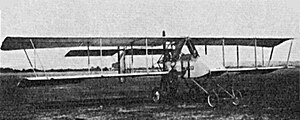Voisin 3
| Voisin 3 | |
|---|---|

| |
| Role | Bomber/Reconnaissance |
| Manufacturer | Voisin |
| Introduction | Aug 1914 [1] |
| Primary users | |
| Number built | 1000 [note 1] |
| Variants | Voisin 4 |
| Wingspan | 14.7 m (48 ft 4 in) [2][3] |
| Engine | 120hp Salmson M9 radial |
| Armament | front flexible Hotchkiss MG 50 kg (110 lb) of bombs[2] |
| Crew | 2 |
| Max Speed | 100 km/h (62 mph)[4][5] to 120 km/h (75 mph)[3] |
| Climb | 1,000 m (3,280 ft) in 12:00[4][5] 2,000 m (6,560 ft) in 23:00[2]-26:00[4][5] |
| Ceiling | 2,800 m (9,190 ft)[4][5] to 3,500 m (11,500 ft)[3] |
| Range | 180 km (110 mi)[2] to 500 km (310 mi)[3] |
| Endurance | 4:00 [4][5] |
The Voisin 1 and 2 were clearly underpowered, but an experiment mounting the 120hp Salmson radial engine proved to be a great boon. The nacelle was strengthened to support the larger engine and changed to all-metal and the undercarriage was strengthened to handle the load while landing. The gunner worked from the rear seat using machine gun mounts over the pilot's head and at the leading edge of the upper wing. It was also known as the Voisin LA. The Voisin 3 found its niche as a bomber, and through 1915 Voisin 3's in army cooperation escadrilles were replaced with Farmans and Caudrons so that Voisins could be concentrated in bombing units. By early 1916 they were being replaced by the Voisin 5, a process that was complete by mid-spring.
When the war started, two of the 23 French escadrilles were Voisin 3 units.[6]
Belgium purchased 12-15 Voisin 3s and sent them to Esc. 6 and 3 until they were replaced by Farman F.40s in late 1916. Italy bought several before deciding to produce more than one hundred of their own, with deliveries beginning in early 1916, where they equipped 5ª, 7ª/27ª, 25ª, and 37ª squadriglias, serving through 1917. Romania obtaind eight in 1915 where they served through late 1916. Russia purchased around eight hundred and built four hundred of their own and they saw wide use throughout the war, including many built by Dux. They were used by Ukraine and the Don Cossacks during the Russian Civil War. The UK purchased or manufactured several dozen but did not send them into active service. [1]
One Type 3 scored the first French air victory on 5 Oct 1914, when a Voisin 3 brought down a German Aviatik near Rheims.[7][8]
(One French source assigns the "Type LA" tag to the 130hp Salmson Canton-Unné-powered Voisin, with over 1000 built, while assigning the "Type 3" nomenclature to the 150hp-powered Voisin, with few built.[9])
For more information, see Wikipedia:Voisin III.
Timeline [note 2] [note 3]

Game Data
Wings of Glory
| Availability | Maneuver | Damage | Dmg Points | Max Alt. | Climb |
|---|---|---|---|---|---|
| Aug14-Nov16 | XC | B | 11 | 9 | 8 |
Card Links
Blue Max/Canvas Eagles
Miniatures and Models
1:144 Scale
- Shapeways: Reduced Aircraft Factory, wow
1:285/6mm/1:288 Scale
- Shapeways: Reduced Aircraft Factory
Resources
Orthographic Drawings
References
- Notes
- Citations
- Bibliography
- Enzo Angelucci, ed. The Rand McNally Encyclopedia of Military Aircraft, 1914-1980. New York: The Military Press, 1983 edition. ISBN 0-517-41021-4.
- Dr. James J. Davilla and Arthur M. Soltan. French Aircraft of the First World War. Flying Machines Press, 1997. ISBN 0-9637110-4-0.
- Alan Durkota, Thomas Darcey, and Victor Kulikov. The Imperial Russian Air Service. Flying Machines Press, 1995. ISBN 0-9637110-2-4
- Vital Ferry. French Aviation During the First World War. Paris: Histoire and Collections, 2014. ISBN 978-2-35250-370-5
- W.M. Lamberton and E.F. Cheesman, Reconnaissance & Bomber Aircraft of the 1914-1918 War. Great Britain: Harleyford Publications Ltd., 1962. ISBN 9780900435027
- Ian Philpott, The Birth of the Royal Air Force. Great Britain: Pen & Sword Books Limited, 2013. ISBN 978-1-78159-333-2
